Critical Analysis of American Nurses Association on Staffing Shortage
VerifiedAdded on 2022/08/24
|7
|1824
|16
Report
AI Summary
This report offers a critical analysis of the nurse staffing shortage, a persistent issue in healthcare, referencing an article by the American Nurses Association (ANA). The analysis explores factors contributing to the shortage, including an aging population, violence in healthcare settings, nurse burnout, and staffing ratios. The report details the ANA's efforts to address these issues, such as advocating for policy changes and proposing minimum staffing levels. It examines the impact of these factors on patient safety, nurse working conditions, and the adoption of new technologies. The report underscores the need for improved policies to protect nurses and create a better working environment, ultimately aiming to motivate future generations to pursue nursing careers. It highlights the correlation between safe staffing levels and optimal patient outcomes.
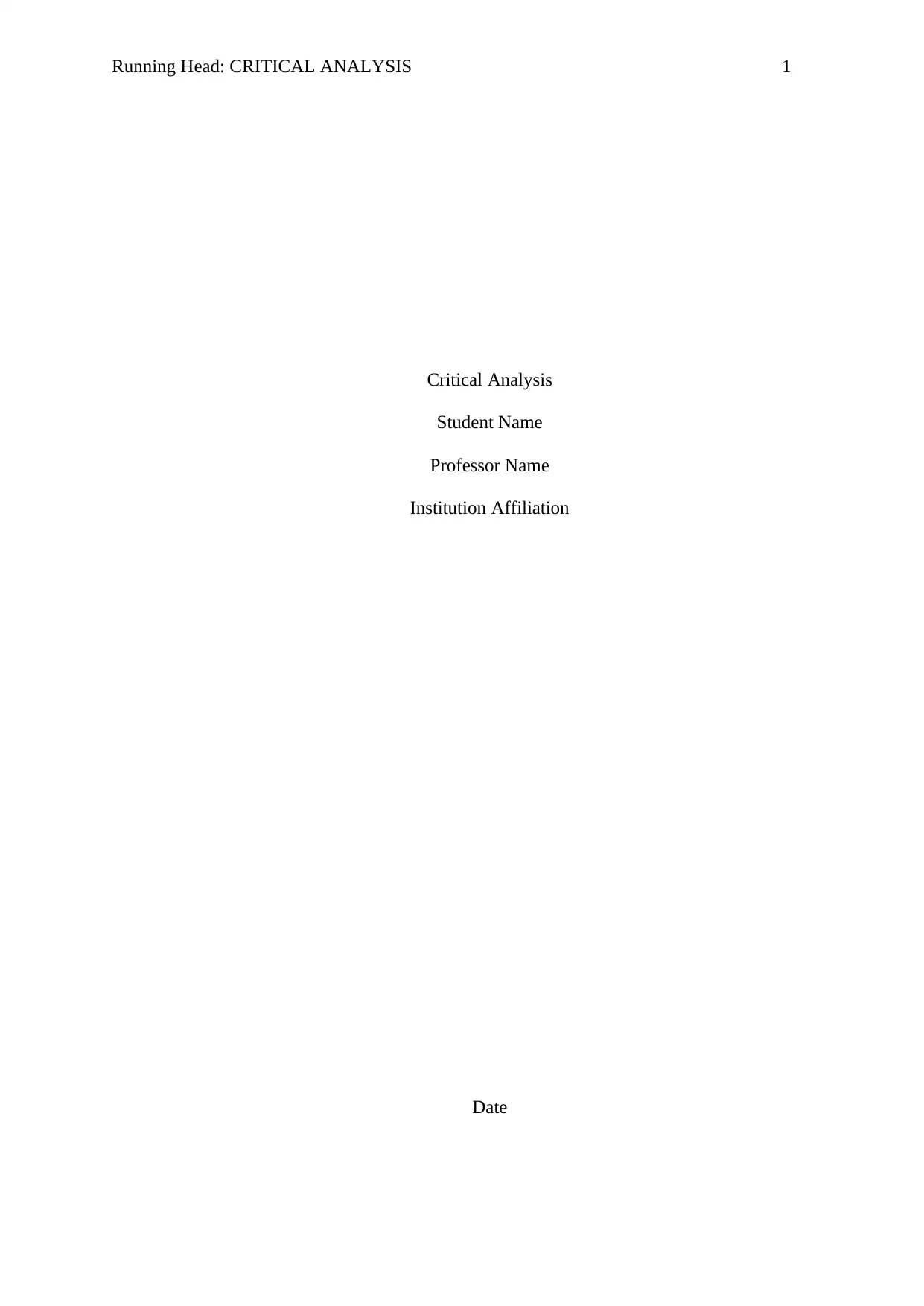
Running Head: CRITICAL ANALYSIS 1
Critical Analysis
Student Name
Professor Name
Institution Affiliation
Date
Critical Analysis
Student Name
Professor Name
Institution Affiliation
Date
Paraphrase This Document
Need a fresh take? Get an instant paraphrase of this document with our AI Paraphraser
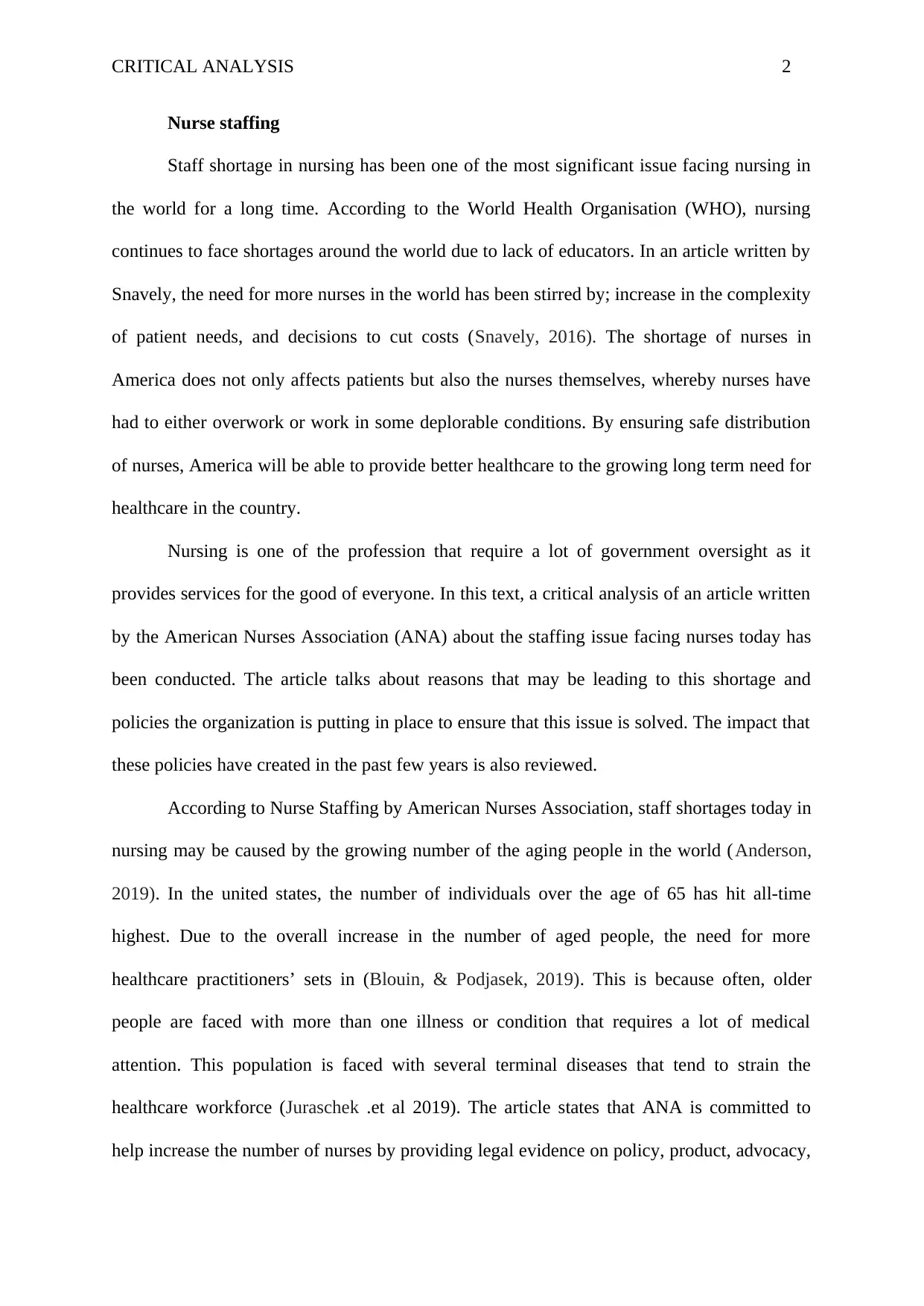
CRITICAL ANALYSIS 2
Nurse staffing
Staff shortage in nursing has been one of the most significant issue facing nursing in
the world for a long time. According to the World Health Organisation (WHO), nursing
continues to face shortages around the world due to lack of educators. In an article written by
Snavely, the need for more nurses in the world has been stirred by; increase in the complexity
of patient needs, and decisions to cut costs (Snavely, 2016). The shortage of nurses in
America does not only affects patients but also the nurses themselves, whereby nurses have
had to either overwork or work in some deplorable conditions. By ensuring safe distribution
of nurses, America will be able to provide better healthcare to the growing long term need for
healthcare in the country.
Nursing is one of the profession that require a lot of government oversight as it
provides services for the good of everyone. In this text, a critical analysis of an article written
by the American Nurses Association (ANA) about the staffing issue facing nurses today has
been conducted. The article talks about reasons that may be leading to this shortage and
policies the organization is putting in place to ensure that this issue is solved. The impact that
these policies have created in the past few years is also reviewed.
According to Nurse Staffing by American Nurses Association, staff shortages today in
nursing may be caused by the growing number of the aging people in the world (Anderson,
2019). In the united states, the number of individuals over the age of 65 has hit all-time
highest. Due to the overall increase in the number of aged people, the need for more
healthcare practitioners’ sets in (Blouin, & Podjasek, 2019). This is because often, older
people are faced with more than one illness or condition that requires a lot of medical
attention. This population is faced with several terminal diseases that tend to strain the
healthcare workforce (Juraschek .et al 2019). The article states that ANA is committed to
help increase the number of nurses by providing legal evidence on policy, product, advocacy,
Nurse staffing
Staff shortage in nursing has been one of the most significant issue facing nursing in
the world for a long time. According to the World Health Organisation (WHO), nursing
continues to face shortages around the world due to lack of educators. In an article written by
Snavely, the need for more nurses in the world has been stirred by; increase in the complexity
of patient needs, and decisions to cut costs (Snavely, 2016). The shortage of nurses in
America does not only affects patients but also the nurses themselves, whereby nurses have
had to either overwork or work in some deplorable conditions. By ensuring safe distribution
of nurses, America will be able to provide better healthcare to the growing long term need for
healthcare in the country.
Nursing is one of the profession that require a lot of government oversight as it
provides services for the good of everyone. In this text, a critical analysis of an article written
by the American Nurses Association (ANA) about the staffing issue facing nurses today has
been conducted. The article talks about reasons that may be leading to this shortage and
policies the organization is putting in place to ensure that this issue is solved. The impact that
these policies have created in the past few years is also reviewed.
According to Nurse Staffing by American Nurses Association, staff shortages today in
nursing may be caused by the growing number of the aging people in the world (Anderson,
2019). In the united states, the number of individuals over the age of 65 has hit all-time
highest. Due to the overall increase in the number of aged people, the need for more
healthcare practitioners’ sets in (Blouin, & Podjasek, 2019). This is because often, older
people are faced with more than one illness or condition that requires a lot of medical
attention. This population is faced with several terminal diseases that tend to strain the
healthcare workforce (Juraschek .et al 2019). The article states that ANA is committed to
help increase the number of nurses by providing legal evidence on policy, product, advocacy,
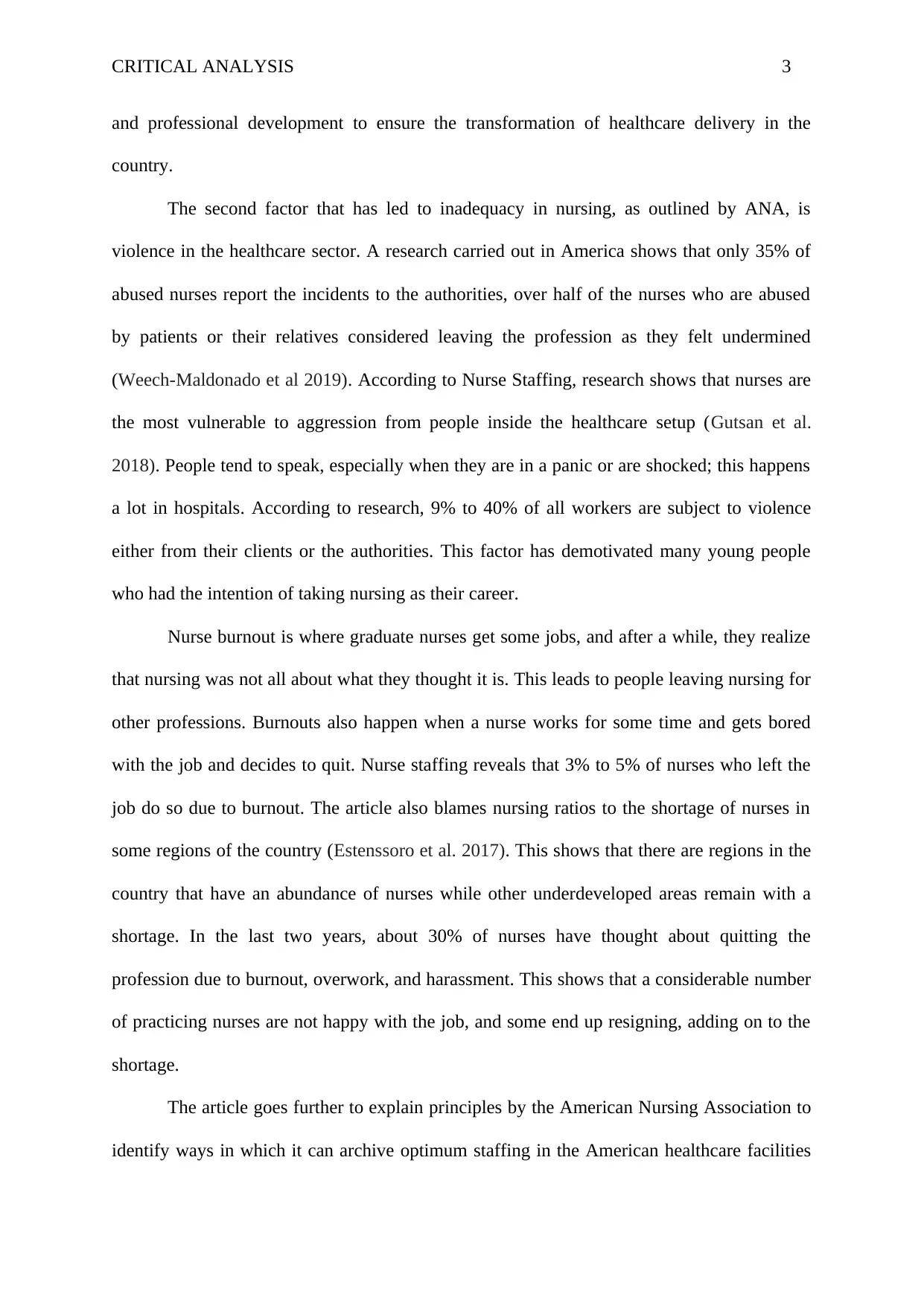
CRITICAL ANALYSIS 3
and professional development to ensure the transformation of healthcare delivery in the
country.
The second factor that has led to inadequacy in nursing, as outlined by ANA, is
violence in the healthcare sector. A research carried out in America shows that only 35% of
abused nurses report the incidents to the authorities, over half of the nurses who are abused
by patients or their relatives considered leaving the profession as they felt undermined
(Weech-Maldonado et al 2019). According to Nurse Staffing, research shows that nurses are
the most vulnerable to aggression from people inside the healthcare setup (Gutsan et al.
2018). People tend to speak, especially when they are in a panic or are shocked; this happens
a lot in hospitals. According to research, 9% to 40% of all workers are subject to violence
either from their clients or the authorities. This factor has demotivated many young people
who had the intention of taking nursing as their career.
Nurse burnout is where graduate nurses get some jobs, and after a while, they realize
that nursing was not all about what they thought it is. This leads to people leaving nursing for
other professions. Burnouts also happen when a nurse works for some time and gets bored
with the job and decides to quit. Nurse staffing reveals that 3% to 5% of nurses who left the
job do so due to burnout. The article also blames nursing ratios to the shortage of nurses in
some regions of the country (Estenssoro et al. 2017). This shows that there are regions in the
country that have an abundance of nurses while other underdeveloped areas remain with a
shortage. In the last two years, about 30% of nurses have thought about quitting the
profession due to burnout, overwork, and harassment. This shows that a considerable number
of practicing nurses are not happy with the job, and some end up resigning, adding on to the
shortage.
The article goes further to explain principles by the American Nursing Association to
identify ways in which it can archive optimum staffing in the American healthcare facilities
and professional development to ensure the transformation of healthcare delivery in the
country.
The second factor that has led to inadequacy in nursing, as outlined by ANA, is
violence in the healthcare sector. A research carried out in America shows that only 35% of
abused nurses report the incidents to the authorities, over half of the nurses who are abused
by patients or their relatives considered leaving the profession as they felt undermined
(Weech-Maldonado et al 2019). According to Nurse Staffing, research shows that nurses are
the most vulnerable to aggression from people inside the healthcare setup (Gutsan et al.
2018). People tend to speak, especially when they are in a panic or are shocked; this happens
a lot in hospitals. According to research, 9% to 40% of all workers are subject to violence
either from their clients or the authorities. This factor has demotivated many young people
who had the intention of taking nursing as their career.
Nurse burnout is where graduate nurses get some jobs, and after a while, they realize
that nursing was not all about what they thought it is. This leads to people leaving nursing for
other professions. Burnouts also happen when a nurse works for some time and gets bored
with the job and decides to quit. Nurse staffing reveals that 3% to 5% of nurses who left the
job do so due to burnout. The article also blames nursing ratios to the shortage of nurses in
some regions of the country (Estenssoro et al. 2017). This shows that there are regions in the
country that have an abundance of nurses while other underdeveloped areas remain with a
shortage. In the last two years, about 30% of nurses have thought about quitting the
profession due to burnout, overwork, and harassment. This shows that a considerable number
of practicing nurses are not happy with the job, and some end up resigning, adding on to the
shortage.
The article goes further to explain principles by the American Nursing Association to
identify ways in which it can archive optimum staffing in the American healthcare facilities
⊘ This is a preview!⊘
Do you want full access?
Subscribe today to unlock all pages.

Trusted by 1+ million students worldwide
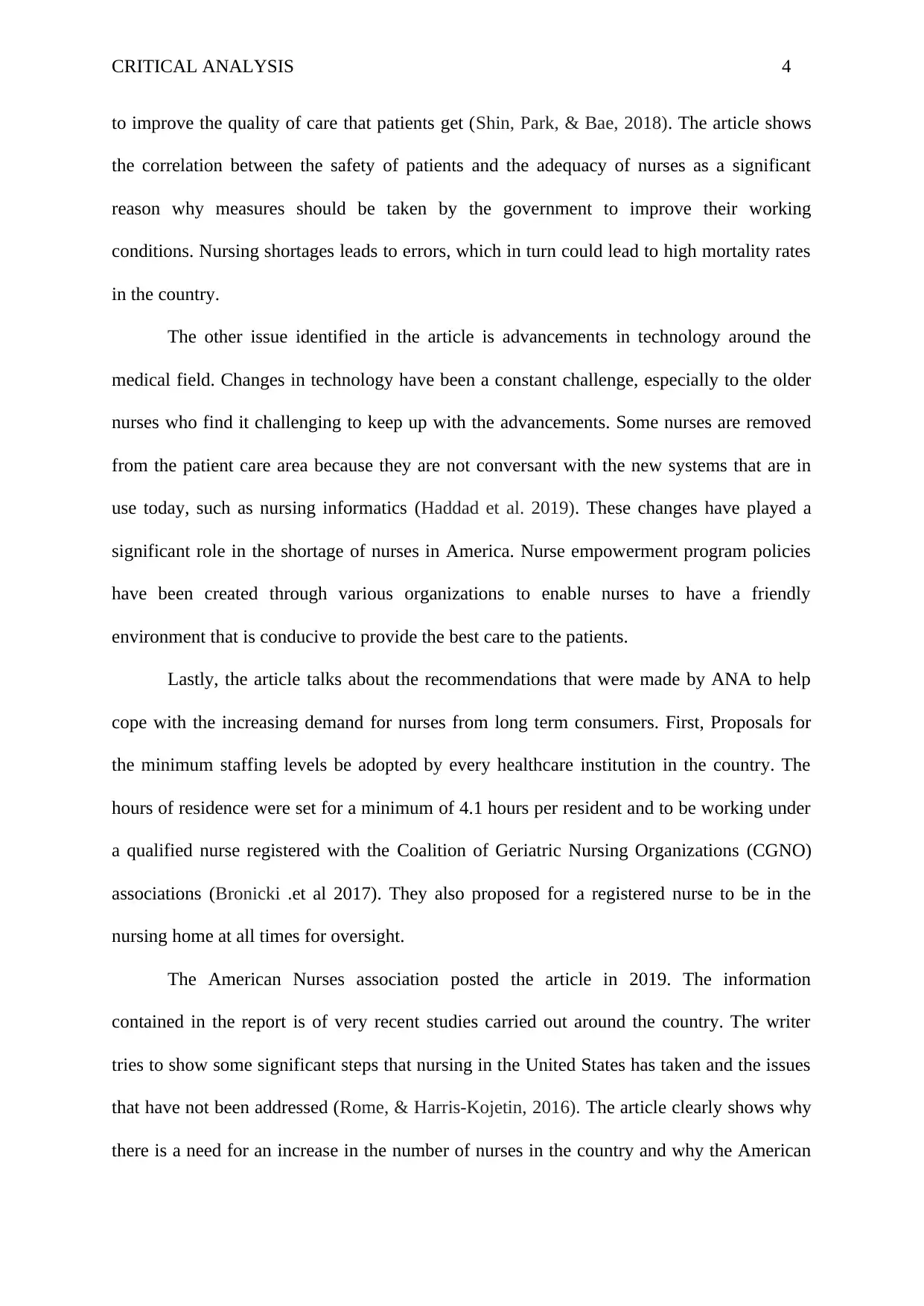
CRITICAL ANALYSIS 4
to improve the quality of care that patients get (Shin, Park, & Bae, 2018). The article shows
the correlation between the safety of patients and the adequacy of nurses as a significant
reason why measures should be taken by the government to improve their working
conditions. Nursing shortages leads to errors, which in turn could lead to high mortality rates
in the country.
The other issue identified in the article is advancements in technology around the
medical field. Changes in technology have been a constant challenge, especially to the older
nurses who find it challenging to keep up with the advancements. Some nurses are removed
from the patient care area because they are not conversant with the new systems that are in
use today, such as nursing informatics (Haddad et al. 2019). These changes have played a
significant role in the shortage of nurses in America. Nurse empowerment program policies
have been created through various organizations to enable nurses to have a friendly
environment that is conducive to provide the best care to the patients.
Lastly, the article talks about the recommendations that were made by ANA to help
cope with the increasing demand for nurses from long term consumers. First, Proposals for
the minimum staffing levels be adopted by every healthcare institution in the country. The
hours of residence were set for a minimum of 4.1 hours per resident and to be working under
a qualified nurse registered with the Coalition of Geriatric Nursing Organizations (CGNO)
associations (Bronicki .et al 2017). They also proposed for a registered nurse to be in the
nursing home at all times for oversight.
The American Nurses association posted the article in 2019. The information
contained in the report is of very recent studies carried out around the country. The writer
tries to show some significant steps that nursing in the United States has taken and the issues
that have not been addressed (Rome, & Harris-Kojetin, 2016). The article clearly shows why
there is a need for an increase in the number of nurses in the country and why the American
to improve the quality of care that patients get (Shin, Park, & Bae, 2018). The article shows
the correlation between the safety of patients and the adequacy of nurses as a significant
reason why measures should be taken by the government to improve their working
conditions. Nursing shortages leads to errors, which in turn could lead to high mortality rates
in the country.
The other issue identified in the article is advancements in technology around the
medical field. Changes in technology have been a constant challenge, especially to the older
nurses who find it challenging to keep up with the advancements. Some nurses are removed
from the patient care area because they are not conversant with the new systems that are in
use today, such as nursing informatics (Haddad et al. 2019). These changes have played a
significant role in the shortage of nurses in America. Nurse empowerment program policies
have been created through various organizations to enable nurses to have a friendly
environment that is conducive to provide the best care to the patients.
Lastly, the article talks about the recommendations that were made by ANA to help
cope with the increasing demand for nurses from long term consumers. First, Proposals for
the minimum staffing levels be adopted by every healthcare institution in the country. The
hours of residence were set for a minimum of 4.1 hours per resident and to be working under
a qualified nurse registered with the Coalition of Geriatric Nursing Organizations (CGNO)
associations (Bronicki .et al 2017). They also proposed for a registered nurse to be in the
nursing home at all times for oversight.
The American Nurses association posted the article in 2019. The information
contained in the report is of very recent studies carried out around the country. The writer
tries to show some significant steps that nursing in the United States has taken and the issues
that have not been addressed (Rome, & Harris-Kojetin, 2016). The article clearly shows why
there is a need for an increase in the number of nurses in the country and why the American
Paraphrase This Document
Need a fresh take? Get an instant paraphrase of this document with our AI Paraphraser
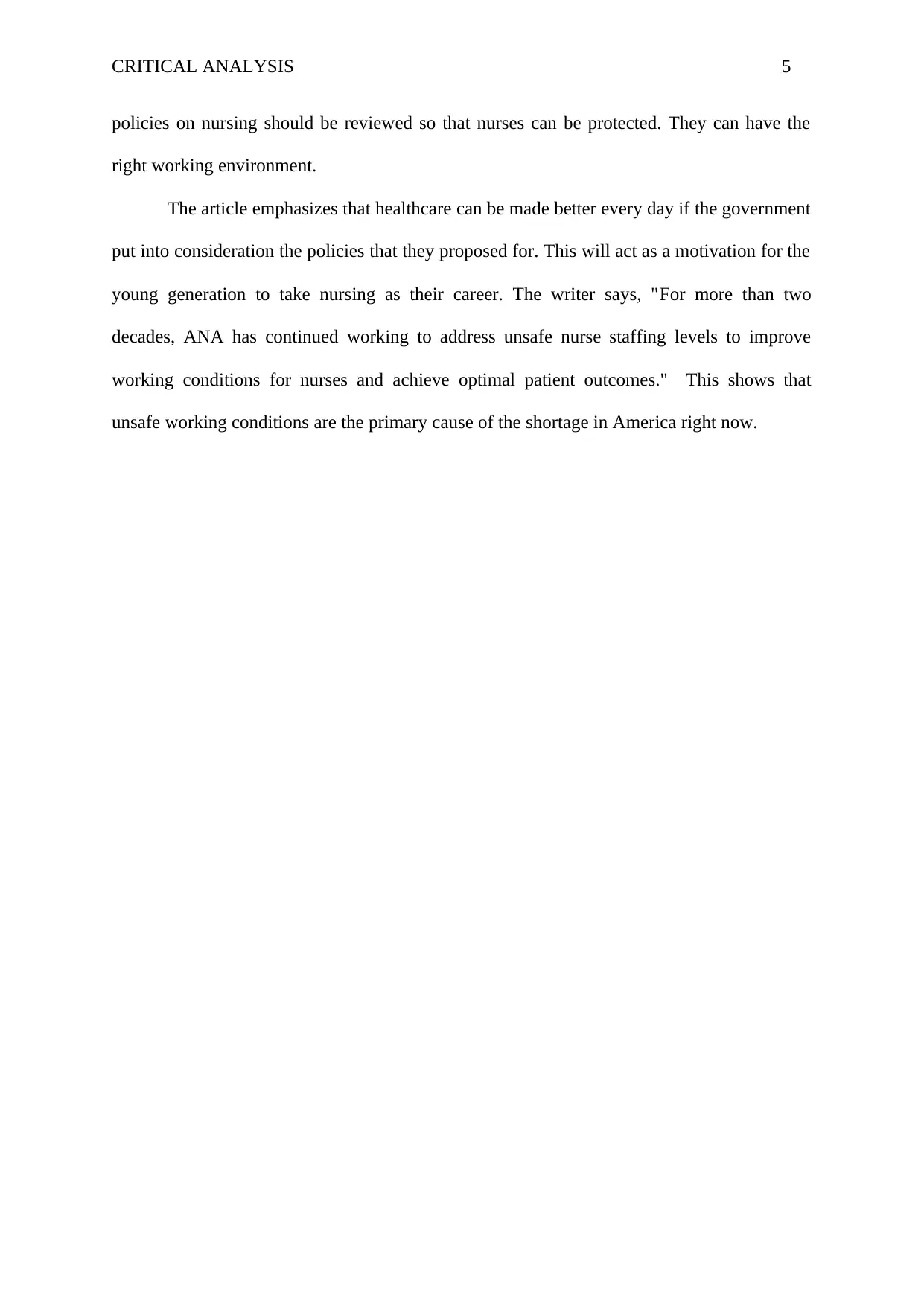
CRITICAL ANALYSIS 5
policies on nursing should be reviewed so that nurses can be protected. They can have the
right working environment.
The article emphasizes that healthcare can be made better every day if the government
put into consideration the policies that they proposed for. This will act as a motivation for the
young generation to take nursing as their career. The writer says, "For more than two
decades, ANA has continued working to address unsafe nurse staffing levels to improve
working conditions for nurses and achieve optimal patient outcomes." This shows that
unsafe working conditions are the primary cause of the shortage in America right now.
policies on nursing should be reviewed so that nurses can be protected. They can have the
right working environment.
The article emphasizes that healthcare can be made better every day if the government
put into consideration the policies that they proposed for. This will act as a motivation for the
young generation to take nursing as their career. The writer says, "For more than two
decades, ANA has continued working to address unsafe nurse staffing levels to improve
working conditions for nurses and achieve optimal patient outcomes." This shows that
unsafe working conditions are the primary cause of the shortage in America right now.
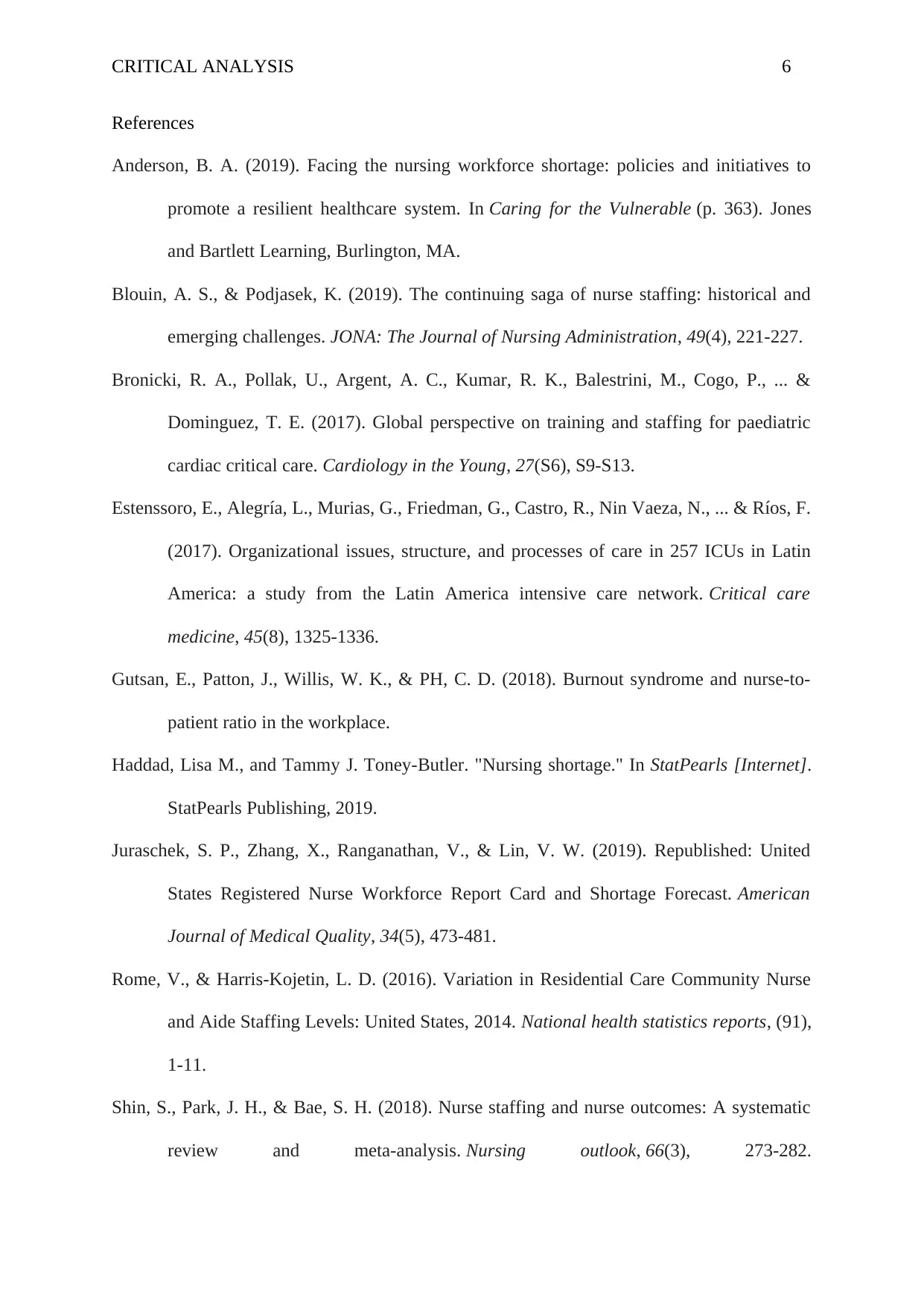
CRITICAL ANALYSIS 6
References
Anderson, B. A. (2019). Facing the nursing workforce shortage: policies and initiatives to
promote a resilient healthcare system. In Caring for the Vulnerable (p. 363). Jones
and Bartlett Learning, Burlington, MA.
Blouin, A. S., & Podjasek, K. (2019). The continuing saga of nurse staffing: historical and
emerging challenges. JONA: The Journal of Nursing Administration, 49(4), 221-227.
Bronicki, R. A., Pollak, U., Argent, A. C., Kumar, R. K., Balestrini, M., Cogo, P., ... &
Dominguez, T. E. (2017). Global perspective on training and staffing for paediatric
cardiac critical care. Cardiology in the Young, 27(S6), S9-S13.
Estenssoro, E., Alegría, L., Murias, G., Friedman, G., Castro, R., Nin Vaeza, N., ... & Ríos, F.
(2017). Organizational issues, structure, and processes of care in 257 ICUs in Latin
America: a study from the Latin America intensive care network. Critical care
medicine, 45(8), 1325-1336.
Gutsan, E., Patton, J., Willis, W. K., & PH, C. D. (2018). Burnout syndrome and nurse-to-
patient ratio in the workplace.
Haddad, Lisa M., and Tammy J. Toney-Butler. "Nursing shortage." In StatPearls [Internet].
StatPearls Publishing, 2019.
Juraschek, S. P., Zhang, X., Ranganathan, V., & Lin, V. W. (2019). Republished: United
States Registered Nurse Workforce Report Card and Shortage Forecast. American
Journal of Medical Quality, 34(5), 473-481.
Rome, V., & Harris-Kojetin, L. D. (2016). Variation in Residential Care Community Nurse
and Aide Staffing Levels: United States, 2014. National health statistics reports, (91),
1-11.
Shin, S., Park, J. H., & Bae, S. H. (2018). Nurse staffing and nurse outcomes: A systematic
review and meta-analysis. Nursing outlook, 66(3), 273-282.
References
Anderson, B. A. (2019). Facing the nursing workforce shortage: policies and initiatives to
promote a resilient healthcare system. In Caring for the Vulnerable (p. 363). Jones
and Bartlett Learning, Burlington, MA.
Blouin, A. S., & Podjasek, K. (2019). The continuing saga of nurse staffing: historical and
emerging challenges. JONA: The Journal of Nursing Administration, 49(4), 221-227.
Bronicki, R. A., Pollak, U., Argent, A. C., Kumar, R. K., Balestrini, M., Cogo, P., ... &
Dominguez, T. E. (2017). Global perspective on training and staffing for paediatric
cardiac critical care. Cardiology in the Young, 27(S6), S9-S13.
Estenssoro, E., Alegría, L., Murias, G., Friedman, G., Castro, R., Nin Vaeza, N., ... & Ríos, F.
(2017). Organizational issues, structure, and processes of care in 257 ICUs in Latin
America: a study from the Latin America intensive care network. Critical care
medicine, 45(8), 1325-1336.
Gutsan, E., Patton, J., Willis, W. K., & PH, C. D. (2018). Burnout syndrome and nurse-to-
patient ratio in the workplace.
Haddad, Lisa M., and Tammy J. Toney-Butler. "Nursing shortage." In StatPearls [Internet].
StatPearls Publishing, 2019.
Juraschek, S. P., Zhang, X., Ranganathan, V., & Lin, V. W. (2019). Republished: United
States Registered Nurse Workforce Report Card and Shortage Forecast. American
Journal of Medical Quality, 34(5), 473-481.
Rome, V., & Harris-Kojetin, L. D. (2016). Variation in Residential Care Community Nurse
and Aide Staffing Levels: United States, 2014. National health statistics reports, (91),
1-11.
Shin, S., Park, J. H., & Bae, S. H. (2018). Nurse staffing and nurse outcomes: A systematic
review and meta-analysis. Nursing outlook, 66(3), 273-282.
⊘ This is a preview!⊘
Do you want full access?
Subscribe today to unlock all pages.

Trusted by 1+ million students worldwide
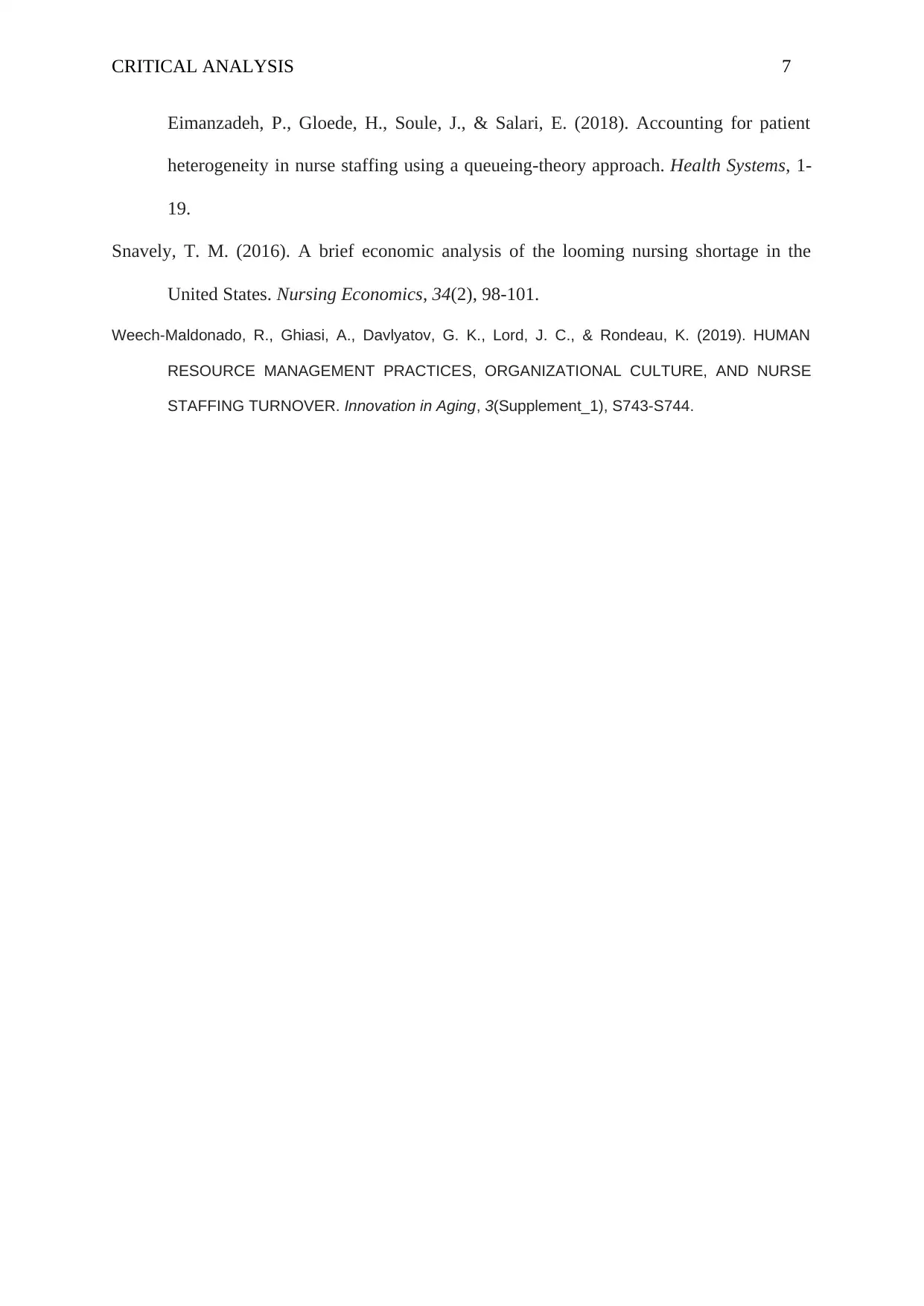
CRITICAL ANALYSIS 7
Eimanzadeh, P., Gloede, H., Soule, J., & Salari, E. (2018). Accounting for patient
heterogeneity in nurse staffing using a queueing-theory approach. Health Systems, 1-
19.
Snavely, T. M. (2016). A brief economic analysis of the looming nursing shortage in the
United States. Nursing Economics, 34(2), 98-101.
Weech-Maldonado, R., Ghiasi, A., Davlyatov, G. K., Lord, J. C., & Rondeau, K. (2019). HUMAN
RESOURCE MANAGEMENT PRACTICES, ORGANIZATIONAL CULTURE, AND NURSE
STAFFING TURNOVER. Innovation in Aging, 3(Supplement_1), S743-S744.
Eimanzadeh, P., Gloede, H., Soule, J., & Salari, E. (2018). Accounting for patient
heterogeneity in nurse staffing using a queueing-theory approach. Health Systems, 1-
19.
Snavely, T. M. (2016). A brief economic analysis of the looming nursing shortage in the
United States. Nursing Economics, 34(2), 98-101.
Weech-Maldonado, R., Ghiasi, A., Davlyatov, G. K., Lord, J. C., & Rondeau, K. (2019). HUMAN
RESOURCE MANAGEMENT PRACTICES, ORGANIZATIONAL CULTURE, AND NURSE
STAFFING TURNOVER. Innovation in Aging, 3(Supplement_1), S743-S744.
1 out of 7
Related Documents
Your All-in-One AI-Powered Toolkit for Academic Success.
+13062052269
info@desklib.com
Available 24*7 on WhatsApp / Email
![[object Object]](/_next/static/media/star-bottom.7253800d.svg)
Unlock your academic potential
Copyright © 2020–2025 A2Z Services. All Rights Reserved. Developed and managed by ZUCOL.





